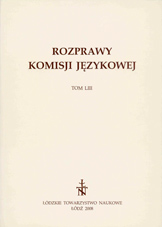Imiona na nekropoliach południowego Podlasia jako odzwierciedlenie pogranicza kulturowego
Names in the cemeteries in southern Podlasie as the reflection of the cultural borderland
Author(s): Feliks CzyżewskiSubject(s): Language and Literature Studies
Published by: Łódzkie Towarzystwo Naukowe
Summary/Abstract: The present paper, based on the anthroponymic material collected from the tombstone inscriptions in the Neo-Uniate cemetery in Kostomłoty near Biała Podlaska, shows the phenomenon of the cultural borderland. Having adopted the definition of the borderland as a spiritual community of a specific local society, arisen in the area where two or several ethnoses and languages meet, the author tries to demonstrate, with the example of forenames, in what ways this local community is divided and what it has in common in the sphere of anthroponyms. The naming of the population inhabiting the Neo-Uniate parish in Kostomłoty took place, as the detailed analysis of names showed, under the influence of two trends represented by the Orthodox Church and by the Roman Catholic Church. The contact of these influences is most fully reflected by the Uniate (Byzantine-Slavonic) Church. The historical perspective applied (19th and 20th centuries), fully taking into account non-linguistic factors, made it possible to obtain names that were common and names that were different from the collection analyzed. The study shows specific onomastic trends typical of the Polish-East Slavonic borderland. When comparing the collection of names obtained from the tombstone inscriptions in Kostomłoty with the appropriate collection of identical names recorded in the vicinity of Biała Podlaska, and with the corresponding collection of names from all over Poland, we find that in the case of a different (high/low) position of particular names on the rating list of Kostomłoty (K) in relation to the position of those names on the name lists collected from the former Biała Podlaska (BP) voievodship and from all over Poland (P) this shows a) their Western, Roman Catholic origin, cf. Teresa 46 (K) : 9 (BP) : 7 (P), Janina 38 (K) : 3 (BP) : 5 (P), Jadwiga 27 (K) : 7 (BP) : 9 (P), or b) their Eastern, Orthodox Church-Byzantine origin, cf. Olga 3 (K) : 25 (BP) : 28 (P), Prakseda (8 (K) : 42 (BP) : 41 (P), Anastazja 11 (K) : 29 (BP) : 31 (P), Ksenia 12 (K) : 40 (BP) : 40 (P). It appears that further studies of the names found on tombstone inscriptions in the cemeteries in the eastern Lublin region will allow us to corroborate this thesis with far greater probability.
Journal: Rozprawy Komisji Językowej
- Issue Year: 2008
- Issue No: 53
- Page Range: 65-78
- Page Count: 14
- Language: Polish

